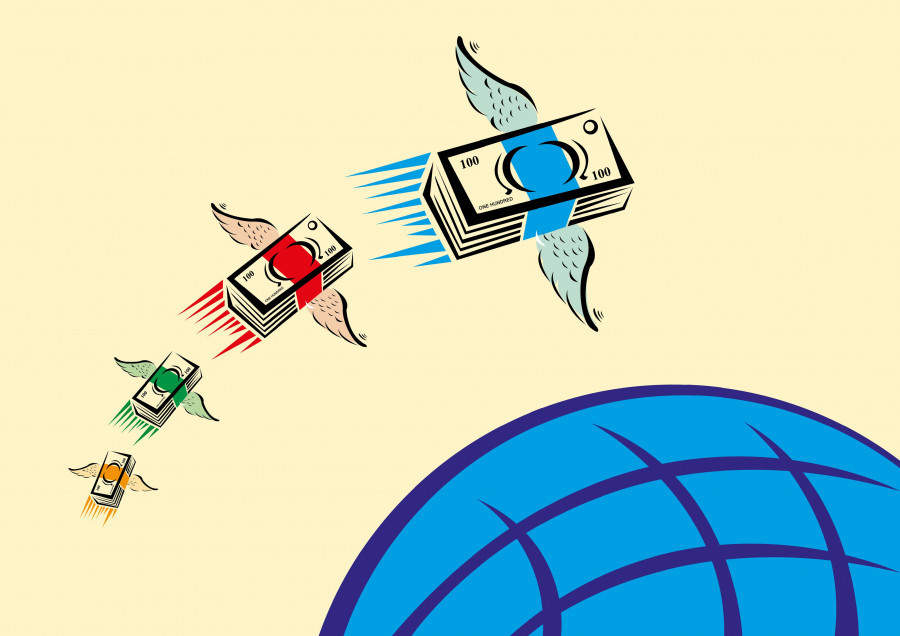Money
Remittance inflows jump 24 percent to Rs585.08 billion
The central bank said that the country’s economy has been in the recovery phase.
Post Report
Remittance inflows to Nepal jumped by a staggering 24.3 percent to Rs585.08 billion in the first half of the current fiscal year that ended mid-January.
In the same period last fiscal year, remittance had decreased by 5 percent.
In US dollar terms, remittance inflows increased 13.9 percent to $4.50 billion in the review period, against a decrease of 5.7 percent in the same period of the previous year, according to Nepal Rastra Bank.
The central bank said that the number of Nepali workers seeking approval for foreign
employment increased 64.6 percent to 275,643 in the review period. The number of Nepali
workers (renew entry) taking approval for foreign employment increased by 9.5 percent to 142,548 in the review period.
In total, 418,191 Nepalis left the country in the first six months of the current fiscal year.
The central bank said that the country’s economy has been in the recovery phase. Gross foreign exchange reserves increased by 10 percent to Rs1,337.29 billion in mid-January 2023 from Rs1,215.80 billion in mid-July 2022.
In US dollar terms, the gross foreign exchange reserves increased 8 percent to $10.30 billion in mid-January 2023 from $9.54 billion in mid-July 2022. Based on the imports of six months of 2022-23, foreign exchange reserves of the banking sector is sufficient to cover prospective merchandise imports of 10.4 months, and merchandise and services imports of 9.1 months.
The year-on-year consumer price inflation remained at 7.26 percent in mid-January
2023 compared to 5.65 percent a year ago.
Food and beverage inflation stood at 5.62 percent whereas non-food and service inflation rose to 8.57 percent in the review month.
Under the food and beverage category, the consumer price index of the restaurant and hotel sub-category increased by 15.56 percent, tobacco products by 11.81 percent, milk products and eggs by 9.70 percent, cereal grains and their products by 9.56 percent and alcoholic drinks by 8.84 percent.
Under the non-food and services category, the year-on-year consumer price index of the transportation sub-category increased by 16.43 percent, health by 11.22 percent, recreation & culture by 8.76 percent, miscellaneous goods and services by 8.68 percent and furnishing and household equipment by 8.33 percent.
During the six months of 2022-23, merchandise exports decreased 32 percent to Rs80.81 billion against an increase of 95.5 percent in the same period of the previous year.
Destination-wise, exports to India and China decreased by 40.1 percent and 25.2 percent respectively whereas exports to other countries increased by 3.6 percent.
Exports of zinc sheet, particle board, cardamom, woollen carpets, polyester yarn and thread, among others, increased whereas exports of soybean oil, palm oil, oil cakes, textiles, silverware and jewellery, among others, decreased in the review period.
Merchandise imports decreased 20.7 percent to Rs792.67 billion against an increase of 51.1 percent a year ago. Destination-wise, imports from India, China and other countries decreased 19.4 percent, 24.6 percent, and 21.4 percent respectively.
Imports of petroleum products, sponge iron, chemical fertiliser, gold, other stationeries, among others, increased whereas imports of transport equipment & parts, medicine, M.S. billet, silver, telecommunication equipment and parts, among others, decreased in the review period.
Nepal’s total trade deficit decreased by 19.2 percent to Rs711.86 billion during the six months of 2022-23.
The central bank said that the balance of payments (BOP) remained at a surplus of Rs97.10 billion in the review period as compared to a deficit of Rs241.23 billion in the same period of the previous year.
In US dollar terms, the BOP remained at a surplus of $734.4 million in the review period against a deficit of $2.02 billion in the same period of the previous year.




 9.12°C Kathmandu
9.12°C Kathmandu












%20(1).jpg&w=300&height=200)
